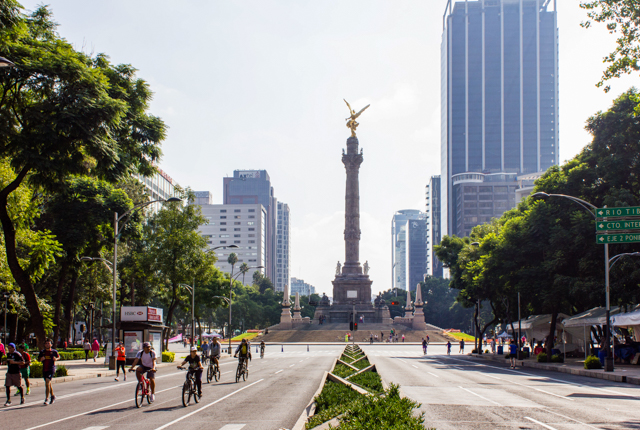
“Please do put together an earthquake plan,” my dad said, after I texted him to let him know that we’d just arrived safely in Mexico City. Armed with the knowledge that my dad is (almost!) always right, I quickly located an emergency exit on the floor of my new apartment building and pointed to the sturdy-ish dining table in our living room. “This would do, right?” I asked my boyfriend, and with that we eagerly went out in search of street tacos.
Turns out, pointing at a table and knowing where the staircase was wouldn’t “do.” It was a lesson that I would learn the hard way when less than a week later, at 1:14 p.m. on Tuesday, September 19th, the walls of our apartment started to crack and the neighborhood around us started to crumble.
I vividly remember looking out the window at the 20-story parking garage across from us and watching the overhead lights sway violently. Equipped with nothing but our mobile phones and pounding hearts, we hid under the same table that I’d so nonchalantly claimed as our safe space, in a state of shock, praying that it would soon be over.
The truth is, despite there being a major earthquake in Mexico just one week prior to our arrival, the chance of another one occurring was hardly on my radar, even though I knew that aftershocks existed. Where I come from, the only natural disaster that we’re concerned about is an ice storm.
When the earthquake was over and the world stopped shaking, we made a dash for the door and evacuated with nothing but our phones and each other.
Here are five lessons that I quickly learned about visiting an earthquake-prone destination.
1. Choose your accommodation wisely.
When choosing your accommodation, it’s best to go for newer buildings in modern neighborhoods, as they’re likely built to better codes. Ask for a room on one of the bottom floors. Views are great, but not when you’re on the 17th floor in an earthquake and can’t use the elevator to evacuate. This time around, we were lucky. After a small battle between “new and modern” and “authentic and cozy,” I stubbornly won the debate and we booked a spot in a new, modern high-rise located in one of the most recently developed parts of Mexico City. Gratefully, our apartment was located on the sixth floor, so we were able to evacuate almost immediately after the earth stopped trembling.
2. Familiarize yourself with your city and your building.
If you’re visiting an area where earthquakes occur, always be prepared. On your first day there, make sure that you find your country’s embassy so that you’ll know where to go in case of emergency. Then, in your own building, always locate the nearest staircase on arrival and use it at least once so that it’s somewhat familiar. After all, there’s no worse feeling than scouring the halls of an unfamiliar building for an emergency exit when you’re already in a panic.
3. Keep key items near the door.
Always have some local currency, a charger pack, and your passport near the door. If you’re not prepared, the only thing that you’ll likely grab while evacuating is your phone, and if you don’t have a full charge or an extra battery pack, you’ll have no way to contact emergency services or your loved ones back home. Additionally, have a bottle of water per person near the door available to grab quickly, particularly if you live in a hot, tropical climate or in a city near the equator. We weren’t allowed to return to our apartment for more than five hours, and the sun shone unapologetically all afternoon. Amid the shock, the heat, and not having one peso in our pockets, having to worry about something as simple as water only added to our anxiety.
4. Have a clear evacuation plan.
If an earthquake hits, know exactly where you’ll run to. Secure yourself between a door frame or underneath a flat surface like a desk or a kitchen table. Try not to panic. My heart was beating out of my chest and my legs felt like Jello. But I never for one moment lost focus on what my next move would be. After the shaking seemed to stop, we bolted for the door and went straight to the shared staircase where people from the office building next to us were also evacuating.
Leave as soon as possible. Take nothing but your prepared pack and always take the stairs. Walk briskly (but calmly) to avoid tripping or falling. Evacuate to the street and get as far away from the buildings, street lamps, and trees as possible. We found ourselves with thousands of others, flocking to the median of one of the largest, busiest streets in Mexico City — Paseo de la Reforma. Traffic had come to a standstill and some people even abandoned their cars. Nearly everyone in the street had their eyes to the sky, proactively looking up to gage what could possibly come crashing down on them.
5. Learn key earthquake vocabulary in the local language.
There’s nothing scarier than experiencing a natural disaster in a country where you don’t speak the language. There were times, immediately after the earthquake, where people in the streets were screaming “la replica!” meaning “aftershock,” and “alejarse!” meaning “move away.” Do yourself a favor and learn some of these words, in whatever language is necessary. Because that’s the thing about earthquakes — you never know when one will hit.
Related Stories:
- What You Need to Know About Your Hotel If a Hurricane Strikes
- 10 Important Things to Do If There’s a Terrorist Attack While You’re Traveling
- 17 Things You Need to Know Before Traveling During Hurricane Season
All products are independently selected by our writers and editors. If you buy something through our links, Oyster may earn an affiliate commission.



